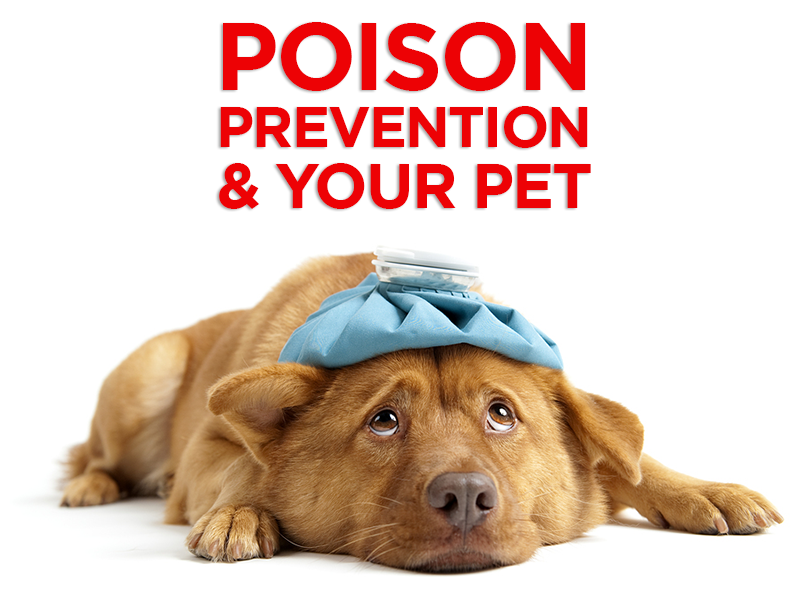
March is designated as Pet Poison Prevention Awareness Month. It was established to help raise awareness and prevent illness and injuries for pets. Us pets can become very ill after ingesting many common household foods, products, and plants. As dogs, we are instinctively curious creatures, and if a container with cleaner, alcohol, medications, etc. is left out, we may be inclined to investigate it. Unfortunately, with our smaller bodies and weight, just a small amount ingested could be fatal! This sounds really scary for both pets and our parents, but understanding what potential harmful poisons exist in our home and yard is the first step to keeping us safe. Some of them are very obvious, but others might be new to you.
Top 10 Dog Poisons
- Chocolate
- Mouse and Rat Poisons (rodenticides)
- Vitamins and Minerals (e.g., Vitamin D3, iron, etc.)
- NSAIDs (e.g., ibuprofen, naproxen, etc.)
- Cardiac Medications (e.g., calcium channel blockers, beta-blockers, etc.)
- Cold and Allergy Medications (e.g., pseudoephedrine, phenylephrine, etc.)
- Antidepressants (e.g., selective serotonin reuptake inhibitors)
- Xylitol (common in toothpaste and chewing gum)
- Acetaminophen (e.g., Tylenol)
- Plants (Lilies, Sago Palma, Poinsettias, etc.)
Top 10 Cat Poisons
- Topical spot-on insecticides
- Household Cleaners
- Antidepressants
- Plants (Lilies, Sago Palma, Poinsettias, etc.)
- Insoluble Oxalate Plants (e.g., Dieffenbachia, Philodendron, etc.)
- Human and Veterinary NSAIDs
- Cold and Flu Medication (e.g., Tylenol)
- Glow Sticks
- ADD/ADHD Medications/Amphetamines
- Mouse and Rat Poison
Symptoms of Accidental Poisoning
Some poisons will result in an immediate reaction for pets while others may take several days to manifest symptoms. While there is not one set of exact symptoms to indicate a pet has been poisoned, there are some general symptoms to look for, including:
- Drooling, vomiting, loss of appetite, diarrhea
- Lethargy, weakness
- Pale or yellowish gums
- Excessive thirst or urination
- Nervousness, hyperactivity, muscle tremors, seizures, coma
Xylitol
I have personal experience with a poison scare. My doggy sister, Willow, ate a WHOLE packet of gum with Xylitol in it. She stole off the kitchen counter, so my mom, Tonya, called poison control, and they walked her through what to do. It was very scary though, and I just want to warn all humans to be sure to keep that stuff off counters for nosy large pups!
Sago Palms
I also have daycare friends who had some scary experiences with Sago Palm poisoning. These plants are popular in outdoor landscaping in Savannah, but every dog and cat needs to beware. All parts of the Sago Palm are poisonous, but the seeds are the most toxic to pets and are easier for them to eat than the prickly fronds.
The Sago Palm toxin, called cycasin, attacks the liver causing a broad range of symptoms. Cycasin irritates the gastrointestinal tract so drooling, vomiting, and diarrhea may be the first signs of poisoning. Dogs and cats with irritated gastrointestinal tracts may refuse to eat. These GI signs may seem minor, but if left untreated, liver failure is imminent. Several of my daycare buddies have gotten very sick after eating Sago Palm seeds, and one of them even died. I was devastated, and now I want to let everyone know just how dangerous these plants are!
Act Quickly
If you suspect your pet has ingested any of these items or any other questionable substance, call the ASPCA Animal Poison Control Center at (888) 426-4435 or call your veterinarian for assistance. Accurate and timely identification of the suspected substance is very important. Having the container, package, or label in hand will save valuable time and may save the life of your pet. For more information you can check out the ASPCA’s Animal Poison Control Center online for even more helpful tips to keep your pets safe.
Woof,
Rex, The Original Hipster Hound

Leave a comment